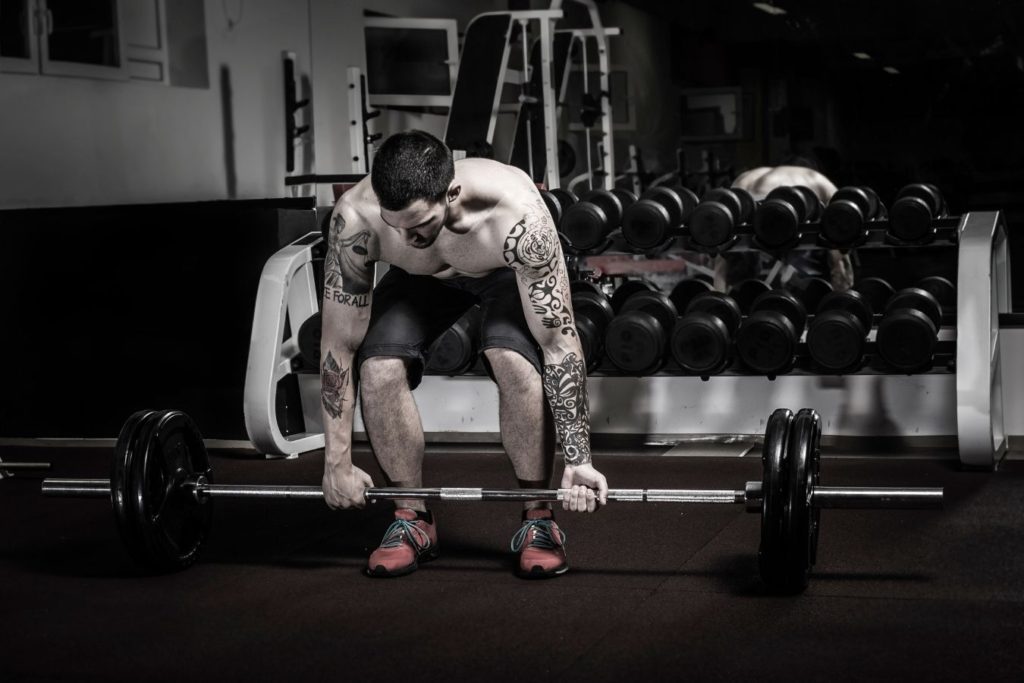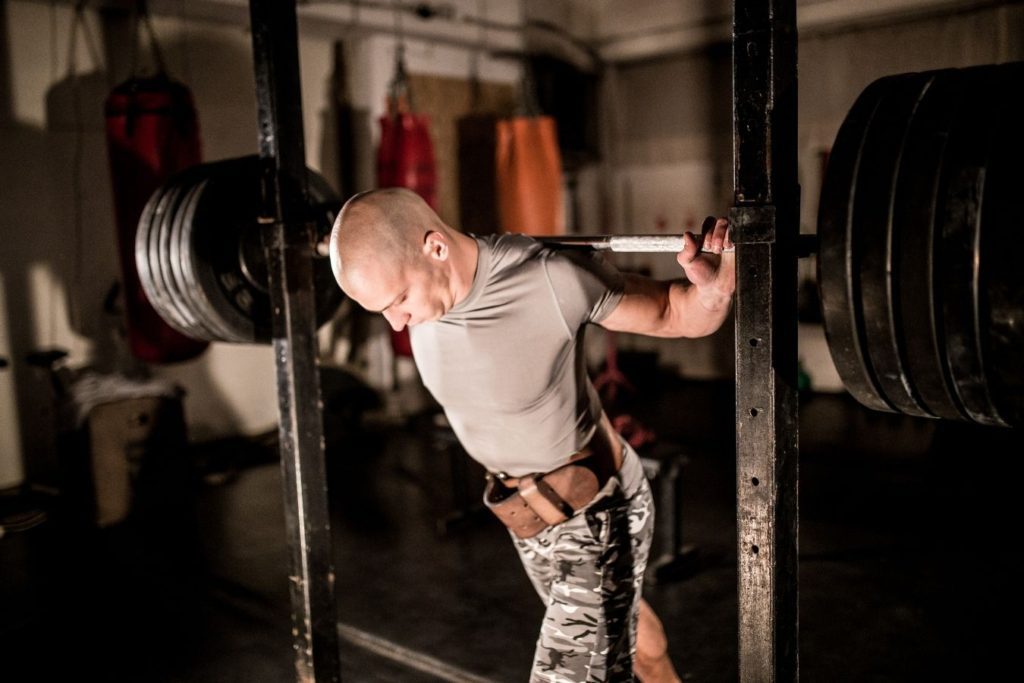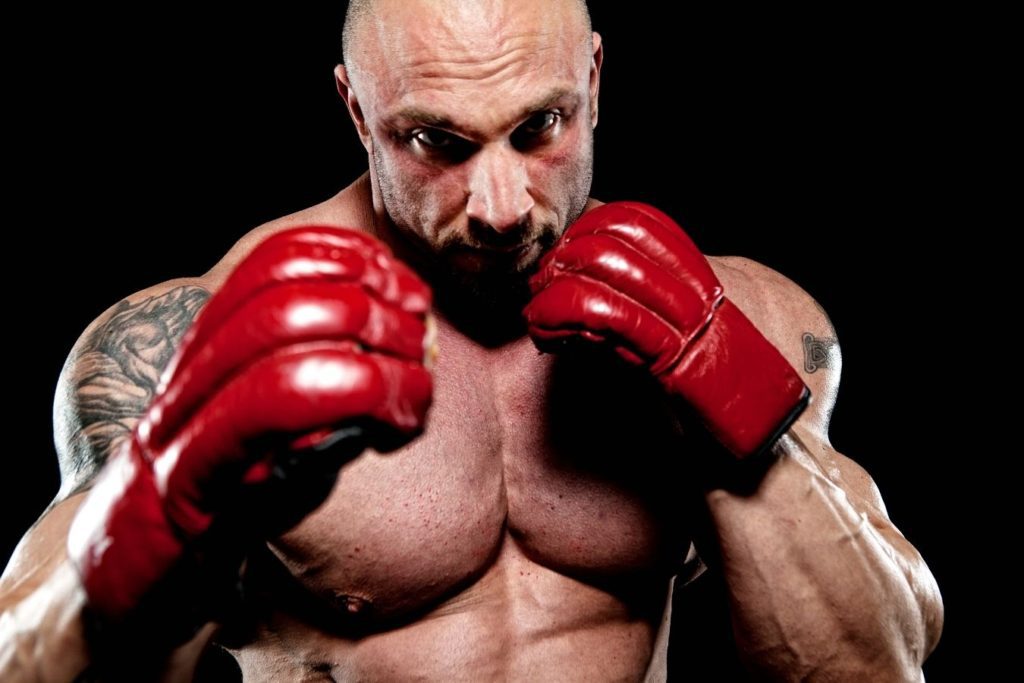So you’ve decided to take up Powerlifting to get stronger for MMA? Or maybe you already are a Powerlifter looking to develop your stand up and ground-based skills? Either way, the strength sport of Powerlifting is often used to train for sports such as MMA.
The Powerlifting movements squat, bench press, and deadlift are great compound exercises to develop overall strength for MMA. However, training the sport of Powerlifting is not great for MMA due to the time and energy needed and the fatigue generated from Powerlifting training.
How can it be that performing the Powerlifting movements is beneficial for MMA but training like a Powerlifter using those exact same movements isn’t good for MMA?
Is Powerlifting Good For MMA?

This is a very broad question and doesn’t take into account how the training is performed. For example, training for the sport of Powerlifting or using Powerlifting principles to guide your strength training are two separate things with different answers.
First, let’s address training the sport of Powerlifting for MMA. Powerlifters generally train 3-4x a week emphasizing maximum strength development specifically for the Back Squat, Bench Press, and Deadlift.

How to Dominate Every Fight with Raw, Explosive Power No One Can Match
Discover the underground blueprint that has quietly turned MMA hopefuls into legends, using nothing but sheer, brute force and bulletproof conditioning techniques.
There are a wide array of Powerlifting programs from high volume such as Sheiko or Smolov to conjugate (training multiple qualities throughout the training week) such as Westside to more basic, general population style programs such as Starting Strength or 5/3/1.
Each style of program has various pros and cons when being used to get stronger for MMA. For example, programs like Smolov have way too much volume to use as supplemental exercises for MMA while 5/3/1 can be manipulated to be lower volume and consists of sub-maximal loading making it a better choice.
Now, the problem with training the sport of Powerlifting is Powerlifting is solely training for maximum strength within the three main lifts. Getting stronger in these three big lifts has its benefits, but there are likely better ways of going about it than a pure Powerlifting style training program.
Training purely for maximal strength has its drawbacks. Mainly due to its opposing adaptations to high-velocity strength.
Two potentially negative adaptations developed from chronic maximal strength training are increases in prime mover activation throughout the range of movement (activation of the main muscle performing the movement; e.g. pecs in the Bench Press) and increases in co-contraction (opposing muscle groups activating together during movement causing slower movement; e.g. biceps and triceps).
The inherent problem with both of these adaptations is they both reduce the speed of movement. As we know, speed is vitally important for the martial artist looking to land strikes or takedowns.
Elite strikers display a double peak muscle activation when striking to enhance both the force and velocity characteristics of a punch. By increasing co-contractions and agonist activation, this becomes more difficult to learn especially if you come from a Powerlifting background.
This is often what you see as “stiffness” in untrained fighters. Especially in a potentially “muscle-bound” Powerlifter. You could say it’s like watching a fridge with arms throwing punches.
Further, MMA requires the ability to repeat high power outputs throughout a 3 x 5-minute bout. While the conjugate method of training incorporates what they call “dynamic” strength training, the exercises performed aren’t fast enough to elicit changes in fast movements such as striking or shooting for takedowns.
Secondly, the sport of powerlifting is performed predominantly in the vertical direction or the axial force vector. MMA is performed in multiple planes of motion of force vectors from side to side to back to front.
Pure Powerlifting training very rarely addresses this which means transfer to the sport of MMA is limited. Overall, training for the sport of Powerlifting as a way to get stronger and improve MMA performance is not a good way of strength training.
However, using Powerlifting principles as a general guide for your maximal strength training is a good option for MMA. At some point in your MMA career, you need to lift some heavy tin. Maximal strength underpins all other strength qualities to a certain point. Being very weak means you aren’t going to display high levels of force quickly, let alone slowly.
Modifying your sets, reps, and intensity of your main exercises during strength training is going to allow you to get stronger and minimize the fatigue that you may carry into your MMA training. Ideally, volume stays relatively low and intensity is moderate to high.
You can even use the main Powerlifting movements the Squat, Bench Press, and Deadlift as your core movements. But most importantly, you place these heavy lifts around your high-velocity strength training such as throws, jumps, plyometric, and special strength exercises.
MMA Fighters That Powerlift

Jon Jones is probably the most notable MMA fighter that extensively trained Powerlifting style. His best lifts were a 600 lb Deadlift, a 345 lb Bench Press, and a 500 lb Squat. These numbers are nothing to scoff at especially for a non-Powerlifter.
However, as his coach Greg Jackson said “Powerlifting’s a problem, he gasses.” Now, I wouldn’t go as far as to say that Powerlifting was the problem. I would say the prioritization and sheer volume of Powerlifting training over other training qualities was the problem.
Throwing Powerlifting under the bus just deters more fighters from incorporating real strength training into their plan.
Squats For MMA
Squats are a great exercise for MMA athletes. You can emphasize different ranges of motion during different training periods. E.g. full range squats during non-competitive periods and half squats during fight build-ups. This way, you can minimize muscular fatigue and hit more “specific” joint angles.
When performing the squat, it’s important not to sit back like a Powerlifter, but rather sit down in-between your knees.
Powerlifters sit back in their squat due to their bar positioning on the back. The low bar means the torso is bent over rather than upright and the knees don’t go over the toes. Further, Powerlifter’s don’t need to squat below parallel so can take advantage of loading the glutes and hamstrings more than the quads.
MMA fighters on the other hand want the knees to travel past the toes. This is a crucial position when shooting for takedowns so having that mobility is important.
But you are not limited to just back squats like a Powerlifter. You have many different variations you can work your way through to strengthen your legs in different ways.
- Front Squat
- Back Squat
- Overhead Squat
- Partial Squat
- Zercher Squat
- Goblet Squat
- B Stance Squat
- Sandbag Squat
- KB Front Rack Squats
- Bulgarian Split Squat
- Split Squat
Various stances and loading positions can strengthen different positions. E.g. B stance (staggered stance) style squats may transfer better to shooting takedowns than performing overhead squats. But what are the benefits of performing any of these squat variations for maximal strength development?
Squats Reduce The Risk Of Knee Injury
37% of injuries occur at the knee in professional UFC fighters during training [1]. The knee is the most commonly injured body part in training with the shoulder coming in second at 18.5%.
By performing strength training that takes the knee through a full range of motion, protective adaptations occur where opposing muscles around the joint activate together (Co-activation as mentioned previously).
Squats Develop Mobility Through The Hips
Being mobile requires the ability to exhibit strength through the range of motion. Meaning mobility isn’t passive like flexibility often is. Being mobile means you are less likely to get injured at extreme ranges of motion.
By loading the hips into a deep squat position or as far as you are able to sit, you put load through the muscles in larger ranges of motion. Hence, developing mobility.
Squatting Develops Leg Strength Which Is Crucial For Knockout Power
Elite strikers have greater contributions from the legs than less experienced strikers when it comes to punching power. Squatting is the ultimate maximum strength developer for the lower body.
Bench Press For MMA
The Bench Press gets a bad rap in many strength and conditioning circles when it comes to sporting performance. Likely because it is closely associated with the “gym bro” culture of chest and biceps every day of the week.
In fact, you’ll often see the bench press touted as a useless exercise for MMA. But very rarely is an exercise useless for a sport. It’s all about the application of the exercise and the context it is used in.
Further, bench press velocity has been shown to be closely related to maximal punching velocity [2]. So you don’t have to stop performing your favorite upper body exercise.
To perform the Bench Press to reduce the risk of shoulder problems, you must tuck your elbows so they form a 45° angle.
Now the setup I am showing here is a Powerlifting style Bench Press. For MMA and other sports, I prefer the grip width to be a close grip with the hands just outside shoulder width. This will also force your elbows closer to your body keeping your shoulders safer and keeping your arms in a “power position” rather than flared away from your body.
Additionally, you’re not stuck with just the Bench Press. There are tons of other horizontal pushing variations especially for those that have shoulder or elbow pain when Barbell Bench Pressing.
- DB Bench Press
- Incline Bench Press
- Push-up
- Decline Push-up
- Hands Elevated Push-up
- Weighted Push-up
- Banded Push-up
- Floor Press
- Landmine Press
Push-up variations are your best friend if you can’t perform the bench press for whatever reason. Those that struggle with shoulder or elbow pain, in my experience, do very well with push-up variations. You can load these heavy too. What are some other benefits of bench pressing for MMA?
The Bench Press Allows You To Handle Heavy Loads
No other upper body exercise allows you to load an exercise this heavy. A stronger bench press often means you’ll be able to perform more and heavier push-ups. Which can translate into better strength endurance of the upper body pushing muscles during MMA.
Deadlifting For MMA
The Deadlift is one of the most rudimentary strength movements. Simply pick something heavy off the floor. There, you’ve just performed a Deadlift.
Deadlifts load the glutes, hamstrings, and lower back which can often be neglected within a training program. When performing the Deadlift, it’s important that it is loaded like a hip hinge and not squat. You can see this in my video below.
Loading the hips and hamstrings before you pull is the key to a proper Deadlift. Now, the conventional Deadlift isn’t the only hip hinge you can perform to level up your posterior.
- Sumo Deadlift
- Romanian Deadlift
- Trap Bar Deadlift
- Good Morning
- Zercher Good Morning
- Staggered Stance Trap Bar Romanian Deadlift
- Staggered Stance Zercher Good Morning
- Single Leg Romanian Deadlift
With so many variations that you can load, there’s no need to be stuck with the Deadlift if it causes you issues. Here are some of the main benefits of performing the Deadlift for MMA.
The Mid-Thigh Pull Is A Maximal Strength Benchmark For Professional UFC Fighters
The mid-thigh pull is essentially an isometric deadlift from the thighs. It is used to rank the strongest UFC fighters within each weight class. While this requires some serious sports technology, the mid-thigh pull is closely related to the Deadlift [3].
This means if you have a strong Deadlift, you will likely have a strong mid-thigh pull.
Deadlifts Train The Grip
Grip strength is an all-important facet of MMA. The ability to keep your hands connected when grappling, man-handling an opponent with no hands connected around their body, or controlling limbs on the ground are all areas of MMA that require high levels of grip strength.
Picking up heavy Deadlifts is one way to train the grip without having to directly address it.
Should You Train The Squat And Deadlift For MMA?
You should not train both the squat and the deadlift for MMA. That doesn’t mean you shouldn’t perform both movement patterns in your program.
From my experience working with professional athletes, performing two big compound full-body movements to develop maximal strength is too fatiguing when you have two plus technical MMA sessions a day. That’s not even including the extra conditioning.
Rather, pick either the squat or deadlift as your core strength movement. Then, supplemental lifts will make up for the other core lift. It may sound confusing but here are examples of both scenarios:
Main Strength Movement:
- Back Squat
Deadlift Movement Options:
- Good Morning
- Romanian Deadlift
- Staggered Stance Zercher Good Morning
Main Strength Movement:
- Deadlift
Squat Movement Options:
- Bulgarian Split Squats
- Zercher Squat
- KB Front Rack Squat
- Front Squat (depending on loading)
By picking the squat or the deadlift as the main option, you’re not stuck with that core movement for life. There is no harm in switching every so often when you don’t have a fight in the near future.
Would Powerlifters Make Good Fighters?

I don’t know of any Powerlifters that have gone into the world of combat sports. However, other pure strength sport athletes have made the transition. Think of Mikhail Koklyaev, Russian Weightlifting Champion and Strongman Competitor who has turned to MMA.
You also have Eddie Hall vs. Hafthor Bjornsson in the near future. Two professional Strongmen taking on boxing.
Before answering the question if Powerlifters make good fighters, we must define what good is. A good fighter is a fighter than possesses the skills to compete at a high level such as the National or the Professional level.
Now, can a strength sports athlete or Powerlifter make a good fighter? Sure. If they put in the time to train over years and years. Saying that Powerlifters would make good fighters because they are strong is a misnomer. Strength isn’t what makes a fighter good. Understanding the sport and possessing the skills to outwit an opponent does.
You may even find a Powerlifter is behind the curve of a normal beginner due to the chronic heavy strength training being performed. The adaptations mentioned in this article that have accrued over the years creates a slower, “stiffer” athlete.
References
1. UFC Performance Institute. A Cross Sectional Performance Analysis And Projection Of The UFC Athlete. 2018.
2. López-Laval, I., Sitko, S., Muñiz-Pardos, B., Cirer-Sastre, R., & Calleja-González, J. (2020). Relationship Between Bench Press Strength and Punch Performance in Male Professional Boxers. The Journal of Strength & Conditioning Research, 34(2), 308-312.
3. De Witt, J. K., English, K. L., Crowell, J. B., Kalogera, K. L., Guilliams, M. E., Nieschwitz, B. E., … & Ploutz-Snyder, L. L. (2018). Isometric midthigh pull reliability and relationship to deadlift one repetition maximum. The Journal of Strength & Conditioning Research, 32(2), 528-533.

